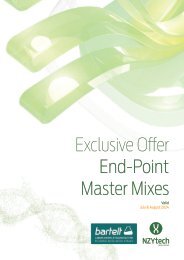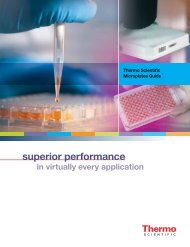PeloBiotech
Create successful ePaper yourself
Turn your PDF publications into a flip-book with our unique Google optimized e-Paper software.
www.pelobiotech.com<br />
diseases. G-CSF is crucial for recovering white blood cell counts after chemotherapy. IFNs like interferon-beta have<br />
antiviral and anti-inflammatory applications. Animal-free versions cater to applications where the absence of<br />
animal-derived components is critical, ensuring ethical and controlled use. This distinguishes them from cGMPproduced<br />
cytokines. Reach out to us for specific details tailored to meet your research needs.<br />
TR-FRET<br />
Time-Resolved Fluorescence Resonance Energy Transfer<br />
(TR-FRET) is a powerful and versatile molecular assay<br />
technique used in biological research and drug discovery.<br />
TR-FRET allows scientists to study molecular interactions<br />
and events within cells or biochemical reactions with high<br />
sensitivity and precision. It is particularly valuable for<br />
measuring protein-protein interactions, receptor-ligand<br />
binding, and various other biomolecular processes.<br />
TR-FRET relies on the principles of fluorescence resonance<br />
energy transfer (FRET), in which energy is transferred from<br />
one fluorophore (the donor) to another (the acceptor)<br />
when they are in close proximity, typically within 10-100<br />
angstroms. The key distinction in TR-FRET is the measurement of the time delay between excitation and emission, which<br />
eliminates short-lived background fluorescence and significantly enhances signal-to-noise ratios.<br />
To perform TR-FRET assays, researchers require specific reagents:<br />
• Donor and Acceptor Fluorophores: These are the fluorescent molecules that emit light when excited by an energy<br />
source. The donor fluorophore, typically a lanthanide chelate (e.g., Europium or Terbium), is excited by a pulsed<br />
light source, and its emission is transferred to the acceptor fluorophore (e.g., XL665 or APC), resulting in a FRET<br />
signal.<br />
• Target Molecules: These are the biological components under investigation, such as proteins, nucleic acids, or<br />
small molecules, labeled with the donor or acceptor fluorophores. The choice of labeling strategy depends on the<br />
specific experiment and the accessibility of the target sites.<br />
• Buffer Solutions: Appropriate buffer solutions are used to maintain physiological conditions and optimize the<br />
stability of the labeled molecules.<br />
• Time-Resolved Detection System: This includes a fluorescence plate reader or a dedicated TR-FRET reader<br />
equipped with the capability to measure the time delay between excitation and emission of the fluorophores.<br />
TR-FRET has revolutionized the field of molecular biology and drug discovery by enabling the study of complex cellular<br />
processes in a high-throughput and sensitive manner. Researchers can use TR-FRET to assess biomolecular interactions,<br />
screen for potential drug candidates, and gain insights into cellular pathways and mechanisms with exceptional accuracy<br />
and efficiency.<br />
Europium chelates<br />
Europium chelates are a class of luminescent compounds widely used in various applications, particularly in the field of<br />
fluorescence-based assays and diagnostics. These chelates consist of europium ions (Eu3+) bound to organic chelating<br />
ligands, which enhance their stability and luminescent properties. Europium ions are known for their unique photophysical<br />
properties, including a long fluorescence lifetime, narrow emission bands, and resistance to photobleaching. These features<br />
66
















